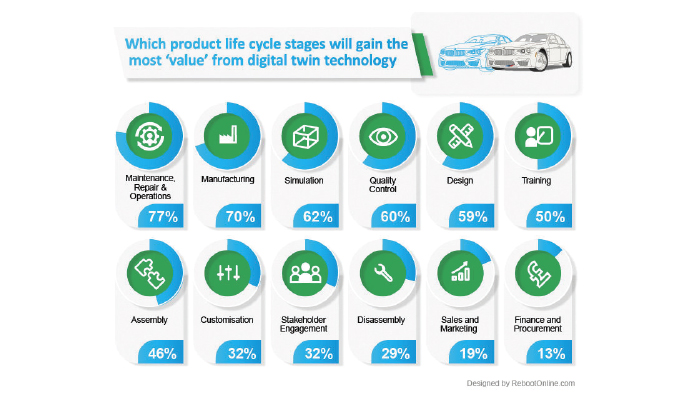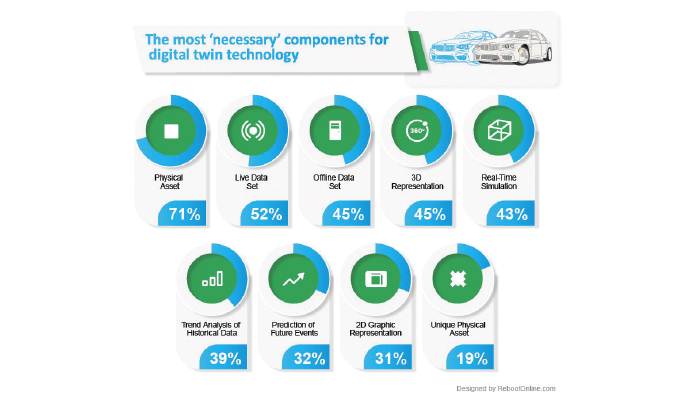One of the biggest developments in the world of technology over the last few years has been that of digital twins. A digital twin is a virtual replica of a physical system, process or product. The technology essentially provides a real-time look at how a physical asset is performing.
Digital twins are already being adopted in industries such as manufacturing, automotive and construction. Consequently, organizations in these respective industries are using digital twin technology to evaluate the performance of given physical assets and then, identifying where improvements can be made to reach more favorable outcomes for the future.
Interested in emerging technologies, digital marketing specialists Reboot Online analyzed the latest findings from research facilities provider Catapult, who surveyed engineers (from a range of disciplines) to better understand the components they believe are the most necessary for digital twin technology to function effectively.
ASSET VALUATION AND REPRESENTATION
Reboot Online found that a “physical asset” (71 percent) is the component engineers think is the most necessary for a digital twin. Thereafter, 52 percent of the experts view a “live data set” as an essential feature for the functionality of digital twins. Also, 45 percent believe an “offline data set” is a very important component for the technology.
Interestingly, with a digital twin being a pairing of the virtual and physical worlds, just 45 percent of engineers rate “3D representation” as a must have variable for the technology. On a similar note, 31 percent state “2D graphic representation” is needed for a digital twin to work properly.
Only 39 percent place ‘trend analysis of historical data’ as a vital attribute for a digital twin. Even less feel ‘prediction of future events’ (32 percent) is a critical aspect that can push the technology to achieve desired objectives.

STAGES IN THE PRODUCT LIFE-CYCLE
Furthermore, Reboot Online also wanted to identify the stages in the product life-cycle that can gain the greatest value from the integration and use of digital twins.
Reboot Online discovered that “maintenance, repair, and operations” (77 percent) is the stage in the product life-cycle where majority of engineers believe digital twin technology adds the greatest value. Thereafter, engineers view “manufacturing” (70 percent) as the next most likely process to benefit from the utilization of digital twin technology.
62 percent of engineers think digital twin technology can be harnessed during the “simulation” of a model that predicts the current and future behavior of a given physical asset. Slightly below, 60 percent feel digital twin technology can be a highly practical for “quality control” testing. Interestingly, 59 percent consider a digital twin to be impactful in the “design” phase of a product/system.
THE FUTURE OF DIGITAL TWINS
Contrastingly, “finance and procurement” (13 percent) is the step in the product life-cycle which engineers think will be able to capitalize the least from the capabilities of digital twin technology. Just above, only 19 percent of engineers place “sales and marketing” as a key operation which can experience significant gains from deploying digital twins.
We are in an era of rapid technological developments. At the forefront of that has been the rise and evolution of digital twins. With the technology having the ability to cover the entire life-cycle of a physical system, process or product; it provides businesses with a powerful analytical tool which can thoroughly assess key performance indicators and provide insights as to where enhancements can be made. In the long-run, the lessons and suggestions taken from digital twins will drive various opportunities for innovation and growth.
- “Maintenance, repair, and operations” (77 percent) is the stage in the product life-cycle where majority of engineers believe digital twin technology provides the greatest value.
- Contrastingly, “finance and procurement” is the operation experts think will benefit the least from the integration and use of digital twins.
- Engineers rank “physical asset” (71 percent) as the essential component for digital twin technology.
- Thereafter, “live data set” is viewed as the next most necessary feature for the functionality of digital twins.
Naomi Aharony is the managing director of Reboot Online. For the study, 150 engineers from a range of disciplines and positions (in terms of seniority) were surveyed by Catapult. Further information on this and other surveys collecting the insights of industrial engineers can be found at www.rebootonline.com.
MODERN PUMPING TODAY, May 2019
Did you enjoy this article?
Subscribe to the FREE Digital Edition of Modern Pumping Today Magazine!



